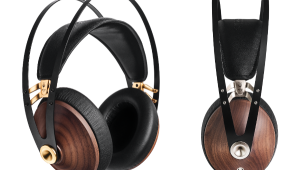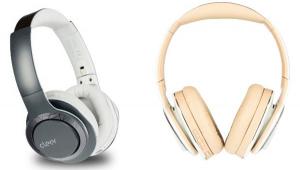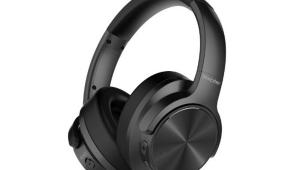This is what I stopped reading this mag a LONG time ago.
Your review of the mdr-x10 is completely retarded. Did you even try the headphones, eq a bit, you know, someone with yout "experience" should know not all ears are the same so no headphone can be best for everyone so there is this magical thing called EQ that can tweak things to your liking. I wont make a crappy headphone good but if it is a quality piece of equipment, it can be adjusted and sound outstanding..and guess what...that is the case of the x10..of course, you were more focused on the stupid celibirity endorsment than on the actual product.
I didnt have a lot of expectatons for it myself but I DID give it a shot for real and was happily surprised.
Very poor article...shame on you!
Review: Sony MDR-X10 Simon Cowell and MDR-1RNC Headphones

Noise cancelling and celebrity-endorsed headphones are two of the biggest categories in big headphones. You can thank Beats for that, I suppose. In one hand, I've got the MDR-1RNC which apparently are not endorsed by the Republican National Committee. At least, I don't think. They've got digital noise cancelling (the headphones, not the Republicans) and some great design and build quality.
In my other hand I've got the shiny MDR-X10's which are "unique and powerful headphones designed by Sony and Simon Cowell." Yeah, they're unique all right.
Six ears give a listen to create one verdict (Well, OK, technically two verdicts).
MDR-1RNC
I can't tell you exactly what it is about the design of the MDR-1RNCs that I like, but I do. The curves and edges, the subtle red accents, these are some great looking headphones. And for $500, they better be. That puts them in a price range where you can get an amazing pair of over-ear headphones, and a great pair of in-ear headphones, with some change coming back to you. What that won't get you is Sony's digital noise reduction, which holds the promise of some excellent noise-dropping performance.
The MDR-1RNC's are very comfortable, with very little physical pressure over the ears. Inside are 50mm "dome type (HD, OFC Voice Coil) Liquid Crystal Polymer Diaphragm" driven by neodymium magnets.
In passive mode, the 1RNCs sounded decent and fairly neutral. The bass was perhaps a touch boomy and lacked much extension, while the treble was a little sibilant, but in neither case was it too bad. Lauren wasn't quite the fan, feeling "if all you listen to is acoustic guitar and vocal, it's OK. The bass is lacking in pitch, the lower mids and upper bass are gone."
Most noise cancelling headphones sound different with the noise cancelling on. Usually, the added processing improves the overall sound. That's not the case with the MDR-1RNCs. The bass practically disappears. The complaints Lauren had with the sound in passive mode are exacerbated with the noise cancelling on. The mid-range gets pushed upwards (or it seems that way at least, given the drop in bass), and the treble takes on a grittier edge.
Brent first exposure with the 1RNC's dual nature was with his first track, "Haru Haru" from K-pop sensations BigBang. He found the sound fairly nice in passive mode, but said "I don't love the highs. They're coarse and unrefined, and cymbals sound like they're made of steel. The tonal balance is just right, though, and the sound is clear, and from the lower treble down, it's largely uncolored." Once he switched on the NC, he found the bass "way overdamped, the voices take on a blaring, ear-straining quality, and the highs go from rough to intolerable."
My first selection was "Midnight City" from M83's Hurry Up, We're Dreaming album. The heavy synth intro with the NC off was a little bitey, but I've heard worse. The bass was full, if lacking a little hard punch like this track can have. With the NC on, however, it was all squak, with none of the driving bass line. It was one of the rare moments I've had with a high-end headphone where I couldn't turn the volume down fast enough.
Brent brought the 80's (OK, late 70's) with "Hands Off She's Mine" from The English Beat. He points out that "this tune is all about driving bass, and with the MDR-1RNC in NC mode, there's NO bass - all the rhythm comes from the rimshots on the snare." Once he switched off the NC, however, "the bass reappears while the highs are tamed (subjectively or electronically, I'm not sure which), and the tonal balance becomes pleasing."
I figured I'd continue with the New Wave, "If You Leave" being my pick, from Orchestral Manoeuvres in the Dark. This song has some strong bass lines up front, with the drums being fairly well balanced with the rest of the track, and overall a decent tonal balance... with the NC off. Turn it on, it's like running the song through a particularly heavy-handed high-pass filter. The bass drops away, and all you're left with is some brittle sounding cymbals and synths.
Brent put it best: "When headphones like the PSB M4U2 sound almost the same in passive and NC modes (and that's without DSP), there's no excuse for this. It's obvious that a lot of thought went into the ID - this is a beautifully designed and built product - but it's like they didn't tune it at all. Maybe they used up all their DSP horsepower doing the NC."
In fairness, the noise cancelling itself is quite good. Still not as good as the best-we've-measured Bose QC15s, but very good. Subjectively, all three of us felt the decrease in sound was above average, with an especially impressive drop in mid-low frequencies (check out Brent's measurements for the actual dB reductions). However, all three of us noticed a weird sort of sharp "suction" effect when the NC is active. It's somewhat uncomfortable/annoying, though less noticeable when there's music going. I'm not sure I'd use these on a long flight.
Measurements: MDR-1RNC
To measured the performance of the MDR-1RNC and MDR-X10, I used a G.R.A.S.43AG ear/cheek simulator, a Clio FW audio analyzer, a laptop computer running TrueRTA software with an M-Audio MobilePre USB audio interface, and a Musical Fidelity V-Can headphone amplifier. Measurements were calibrated for ear reference point (ERP), roughly the point in space where your palm intersects with the axis of your ear canal when you press your hand against your ear. I experimented with the position of the headphones' earpads by moving them around slightly on the ear/cheek simulator to get the best seal and the most representative response curves.
The MDR-1RNC's frequency response measurements in NC and passive modes are similar above 2 kHz, but radically different below. In NC mode, there's a large reduction in response below 400 Hz, but a big bass peak at 15 Hz that will be practically inaudible even with bass-heavy music. A strange tuning choice, to be sure. In passive mode, there's a broad bass boost up to about 300 Hz, which is a much more typical tuning for an over-ear headphone. Adding 70 ohms output impedance to the V-Can's 5-ohm output impedance to simulate the effects of using a typical low-quality headphone amp has very little effect on frequency response in NC mode (as expected), but in passive mode it reduces bass response by -2 dB at 40 Hz, -3 dB at 20 Hz.
Except for a little peak at 4 kHz, total harmonic distortion (THD) at 100 dBA is very low in NC mode and fairly low in passive mode (2% to 3% below 100 Hz). Impedance is dead flat at 51 ohms in NC mode, and in passive mode runs from 30 ohms in the bass to 19 ohms above 200 Hz. The digital noise cancellation is particularly effective at cancelling noise in the band between 80 and 250 Hz, where it maxes out at about -25 dB. In this band, it is the only noise-cancelling headphone we've tested that equals the class leader, the Bose QC-15, although the QC-15's isolation is better between 200 Hz and 1 kHz. Surprisingly, the MDR-1RNC's isolation at high frequencies is better in passive mode.
Average sensitivity with a 1 mW signal at 16 ohms rated impedance in passive mode is 96.7 dB from 300 Hz to 6 kHz. At 52 ohms impedance in NC mode, it's 102.0 dB. - Brent Butterworth
Bottom Line
With a metric ton of noise cancelling headphones on the market, the MDR-1RNCs have a lot of competition. Since the best noise cancelling we've found comes from the much cheaper Bose ($299), while the Parrot Zik ($399) and PSB M4U2 ($400) both offer superior sound quality, the only thing the MDR-1RNC brings to the table for its higher price is an attractive design and sub-par NC-on sound quality.
- Log in or register to post comments





































































